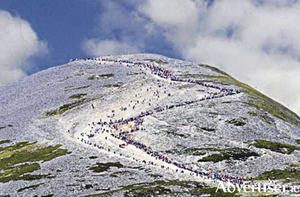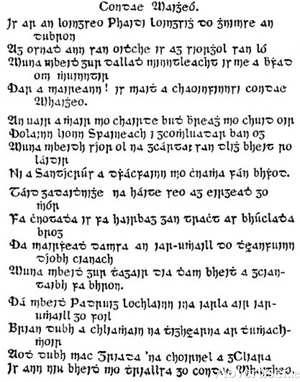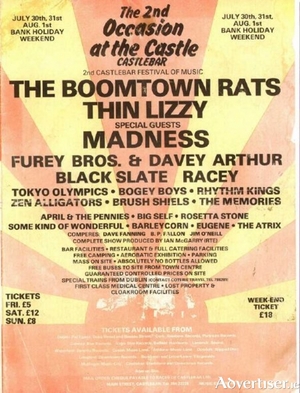Mayo co-operative creameries, the original cash cow
Fri, Nov 04, 2016
Irish farmers learned a long time ago that, in certain circumstances, working in co-operation could lead to real progress and maximised profit for each individual. The meitheal system, whereby a farmer would assist a neighbouring farmer, who would in turn reciprocate that help when needed, was a well established tradition in rural Ireland. The spirit of the meitheal was evident in the beginnings of the Irish co-operative movement. Co-operatives were operating since the 1880s and the concept of voluntary association among farmers went through strong periods as well as years of slow development.
Read more ...An eighties classic is being rebooted on Saturday
Fri, Oct 28, 2016
Johnny Logan won the Eurovision for the first time, veteran republican Tom Barry died, retired international Robbie Keane was born, and Knockmore and Castlebar Mitchels last met in the Mayo senior club championship final. The year was 1980 and that final saw the meeting of two Mayo footballing traditions. Mitchels, founded in 1885 was the oldest club in the county, while Knockmore, though founded in 1958, were not registered until 1960. Mitchels had 24 senior titles in the bag to Knockmore’s one before the 1980 final. However, it could be said that the playing field had been levelled on the run in to the decider as both teams had shown recent good form. Mitchels had taken the 1978 title by a point against Claremorris and Knockmore were beaten finalists in 1979. Two early Knockmore goals in the 1979 semi-final had knocked champions Castlebar out of contention. Knockmore’s opponents in the final were the all-conquering Garrymore side. Garrymore had completed the three-in-a-row from 1974 to 76 (the last club to do so), and it took a replay for them to be beaten in the 1977 final.
Read more ...The television will not be revolutionised
Fri, Oct 21, 2016
If I told my four-year-old son that Irish television only provided one channel at the time of his father’s birth he would probably laugh, thinking the very notion as being inconceivable. In contrast, his generation will grow up with a multitude of portable devices on which to watch TV and movies. Consequently, the television set has lost its monopolistic control over our personal entertainment, impressionable thoughts, and consumer behaviour. Public trends and industrial production, or perhaps vice-versa, have moved on and may never return this way. Though it is far from dead, it is not that long ago since the television set was the internet of its era.
Read more ...Blueshirts march on Cooneal
Fri, Oct 14, 2016
At the January 1933 general election Éamon de Valera’s Fianna Fáil retained power by increasing its seat count to 77. Since its first general election in 1927, the party had increased its Dáil representation at every subsequent contest. In order to halt Fianna Fáil’s march, opponents of de Valera formed a new party in September 1933 by merging the bulk of the membership of the pro-Treaty Cumann na nGaedheal with two smaller conservative groupings, the National Centre Party and the National Guard (a fascist group known as the Blueshirts). Fine Gael — The United Ireland Party was formed and immediately began the process of holding Cumann na nGaedheal’s core support and growing its membership base.
In early February 1934, a UIP (as the party was often referred to) rally took place in Cooneal in north Mayo. The main speakers were Patrick Belton, TD for Dublin North, and Michael Davis, TD for Mayo North. Belton had a personal hatred of de Valera ever since his own expulsion from Fianna Fáil for breaking party policy and taking the Oath of Allegiance in order to enter the Dáil in 1927. At the Cooneal rally, Belton did not hide his loathing of de Valera. Flanked by Blueshirts in berets from Ardagh, Lahardane, and Knockmore, Belton took to the stage wearing a Blueshirt uniform under his coat. It was an act of defiance and a show of support for General Eoin O’Duffy, who as leader of the Blueshirts, had been arrested in Westport a few weeks previously for wearing the group’s uniform. Listing his own nationalist credentials, among them the swearing of Michael Collins into the IRB, Belton commended O’Duffy’s actions in Westport when he insisted the general “was fighting for the expression of the will of the majority of the Irish people against a dictatorship of the people led by de Valera”.
Read more ...Lucan and the Charge of the Light Brigade
Fri, Oct 07, 2016
It was the action that went down in military history as much for its commanders’ incompetence as for its soldiers’ perceived heroism.
Read more ...The taming of the Blue: Act 2
Fri, Sep 30, 2016
The first thing to strike me when I entered Croke Park two weeks ago was that Mayo fans had very obviously and deliberately populated Hill 16 in big numbers. The Blue army’s sense of ownership of the historic terrace, as reinforced during the 2006 ‘Mill at the Hill’, had again been challenged. While mutual respect remains, the Mayo fans’ sense of inferiority and their Dublin counterparts' sense of entitlement have both been eroded to a point where near equilibrium has been reached. The Mayo team too, learned some years back that nothing and no one is sacred in top flight GAA. That understanding did not come in some midnight revelation, but through years of proving it so on the pitch.
Read more ...When the Mayo oligarchy ruled all
Fri, Sep 23, 2016
During the Georgian era, powerful Protestant families owned large tracts of land throughout County Mayo and the province of Connacht. The Castlebar based Bingham family, together with the descendants of Sir Arthur Gore (1685-1742), formed a family compact or oligarchy through marriage and blood whereby political appointments and other influential positions would be secured among themselves. In an era when marriage was determined by the spirit of collateral calculation, the children of Sir Arthur Gore and Elizabeth Annesley would cement the oligarchy.
Their son Arthur Gore (1703-73), became the 1st Earl of Arran. A daughter Elizabeth married James Cuffe (1707-62), son of Gerald Cuffe, who built Elmhall and grandson of Sir James Cuffe, who was granted lands in Ballinrobe in 1667. James Cuffe’s (1707-62) uncle through marriage was Sir Henry Bingham (1654-1714), 3rd Baronet of Castlebar. The Bingham baronets became the Earls of Lucan in 1795. Elizabeth and James’s son James Cuffe (1745-1821) became 1st Baron Tyrawley and sat as MP for Mayo from 1768-97. Anne Gore, another daughter of Sir Arthur and Elizabeth, married John Browne (1709-76), 1st Earl of Altamont. The extremely wealthy and powerful families of the Gores, Cuffes, and Brownes were now first cousins and, in turn, the Binghams were inducted into the oligarchy through their relationship to the Cuffes. In County Mayo, being the remotest part of Ireland from intercourse with the interior of the kingdom and the capital, the oligarchy was an essential component of the Crown’s local government system.
Read more ...Croagh Patrick, then and now
Fri, Sep 09, 2016
There are not many locations within the boundaries of Mayo from where a vista of Croagh Patrick cannot be gained from even the smallest naturally raised platform. The mountain, with its distinctive pyramidal shape, is an iconic symbol of the county for the people of Mayo. Better known today as a venue for an annual Christian pilgrimage, the Reek’s history is one of changing uses.
Read more ...Mayo’s seventeenth century rebel song
Fri, Sep 02, 2016
I recently stumbled upon a 17th century song, as you do, which was dedicated to the county of Mayo. The song, titled "The County of Mayo", initially caught my eye as it was printed in the old Irish type, a rare sight nowadays. The author was a man named Thomas Lavelle who was active during the middle of the 1600s.
Read more ...1879 - a forgotten year of famine and fury
Fri, Aug 26, 2016
It may not be scorched on the Irish psyche as the Great Famine of 1845-52 is, but the famine of 1879, which affected the west more than any other region, brought suffering and led to an increase in agrarian offences committed by furious and despairing tenants. In 1879 the Great Famine was still a painful memory for a large number of people. Most had witnessed first-hand family and friends die a slow, torturous, death by starvation, and had parted indefinitely with family members who had emigrated in an attempt to escape the living hell of famine. The population of Mayo fell by almost 30 per cent during the Great Famine due to death and emigration, and by 1879 the county was still recovering.
The weather in the weeks leading to the traditional harvest time of autumn was reported to have been poor with torrential rainfalls and lightning storms accompanied by high winds at times. Despite the lessons learned during 1845-52, Mayo farmers remained dependent on the potato crop because, except for limited areas mainly in south Mayo, conditions would not support any other crop. The wet weather, as it had done in the 1840s, brought on the feared blight. The telltale signs of an infected plant, the browning leaves followed by dying plants, spread panic through the county. The crop failure was swift and widespread and its effect instant. A visitor to Mayo in late August reported, “the entire community appears to me to be separated only by a film from an unknown abyss.”
Read more ...It’s a Long Way for Tipperary
Fri, Aug 19, 2016
This week, 100 years ago, British soldiers took part in the Great War battles of Doiran and Mlali. At Doiran, the British and French forces were repeatedly pushed back and finally overpowered by the Bulgarian second infantry division, while at Mlali, the British were victorious over the Germans. Victory and defeat followed each other all too frequently during the four years of the Great War.
Early misconceptions that the war would be over by Christmas 1914 quickly evaporated as battles and blockades forced more nations to choose sides and fight. The change in fortunes of the British Forces predictably led to changes in the morale of its men. British officers identified that their troops needed something to bind them, something to remind them that they would be going home to the very homes they were fighting for. For two years before the war started in June 1914, a likeable number was entertaining music hall patrons across Britain. "It’s a Long Way to Tipperary" was an upbeat song that typified the feeling among many Irish working in Britain at the time who were longing for their Irish home. At the outbreak of war the song quickly became the unofficial song of the Connacht Rangers and subsequently of all fighting Tommies of the British army.
Read more ...The Woodstock of the west remembered
Fri, Aug 12, 2016
This month marks the 35th anniversary of one the boldest and most imaginative private ventures to be undertaken in Mayo. The year was 1981 and the plan was to transform a 65 acre site outside Castlebar into the biggest two-day rock festival ever staged in the province. The proposal was the brainchild of brothers Tommy and John Staunton and local hotelier Tony McHugh. The substantial sum of £120,000 was invested in the festival with half going toward enticing major acts to play over the August bank holiday weekend.
Read more ...



